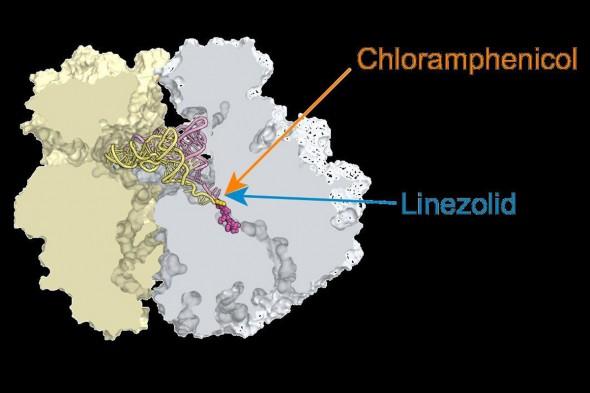Two antibiotics fight bacteria differently than thought

Chloramphenicol, linezolid stall ribosomes at specific mRNA locations. Credit: Alexander Mankin, UIC
Ribosomes are among the most complex components in the cell, responsible for churning out all the proteins a cell needs for survival. In bacteria, ribosomes are the target of many important antibiotics.
The team of Alexander Mankin and Nora Vazquez-Laslop has conducted groundbreaking research on the ribosome and antibiotics. In their latest study, published in the Proceedings of the National Academy of Sciences, they found that while chloramphenicol and linezolid attack the catalytic center of the ribosome, they stop protein synthesis only at specific checkpoints.
“Many antibiotics interfere with the growth of pathogenic bacteria by inhibiting protein synthesis,” says Mankin, director of the UIC Center for Biomolecular Sciences and professor of medicinal chemistry and pharmacognosy. “This is done by targeting the catalytic center of the bacterial ribosome, where proteins are being made. It is commonly assumed that these drugs are universal inhibitors of protein synthesis and should readily block the formation of every peptide bond.”
“But — we have shown that this is not necessarily the case,” said Vazquez-Laslop, research associate professor of medicinal chemistry and pharmacognosy.
A natural product, chloramphenicol is one of the oldest antibiotics on the market. For decades it has been useful for many bacterial infections, including meningitis, plague, cholera and typhoid fever.
Linezolid, a synthetic drug, is a newer antibiotic used to treat serious infections — streptococci and methicillin-resistant Staphylococcus aureus (MRSA), among others — caused by Gram-positive bacteria that are resistant to other antibiotics. Mankin's previous research established the site of action and mechanism of resistance to linezolid.
While the antibiotics are very different, they each bind to the ribosome's catalytic center, where they were expected to inhibit formation of any peptide bond that links the components of the protein chain into a long biopolymer. In simple enzymes, an inhibitor that invades the catalytic center simply stops the enzyme from doing its job. This, Mankin said, had been what scientists had believed was also true for antibiotics that target the ribosome.
“Contrary to this view, the activity of chloramphenicol and linezolid critically depends on the nature of specific amino acids of the nascent chain carried by the ribosome and by the identity of the next amino acid to be connected to a growing protein,” Vazquez-Laslop said. “These findings indicate that the nascent protein modulates the properties of the ribosomal catalytic center and affects binding of its ligands, including antibiotics.”
Combining genomics and biochemistry has allowed the UIC researchers to better understand how the antibiotics work.
“If you know how these inhibitors work, you can make better drugs and make them better tools for research,” said Mankin. “You can also use them more efficiently to treat human and animal diseases.”
###
James Marks, Krishna Kannan, Emily Roncase, Dorota Klepacki, Amira Kefi and Cedric Orelle, all of UIC, are co-authors on the publication. The research was funded by National Institutes of Health grant AI 125518.
Media Contact
All latest news from the category: Life Sciences and Chemistry
Articles and reports from the Life Sciences and chemistry area deal with applied and basic research into modern biology, chemistry and human medicine.
Valuable information can be found on a range of life sciences fields including bacteriology, biochemistry, bionics, bioinformatics, biophysics, biotechnology, genetics, geobotany, human biology, marine biology, microbiology, molecular biology, cellular biology, zoology, bioinorganic chemistry, microchemistry and environmental chemistry.
Newest articles

Bringing bio-inspired robots to life
Nebraska researcher Eric Markvicka gets NSF CAREER Award to pursue manufacture of novel materials for soft robotics and stretchable electronics. Engineers are increasingly eager to develop robots that mimic the…

Bella moths use poison to attract mates
Scientists are closer to finding out how. Pyrrolizidine alkaloids are as bitter and toxic as they are hard to pronounce. They’re produced by several different types of plants and are…

AI tool creates ‘synthetic’ images of cells
…for enhanced microscopy analysis. Observing individual cells through microscopes can reveal a range of important cell biological phenomena that frequently play a role in human diseases, but the process of…





















